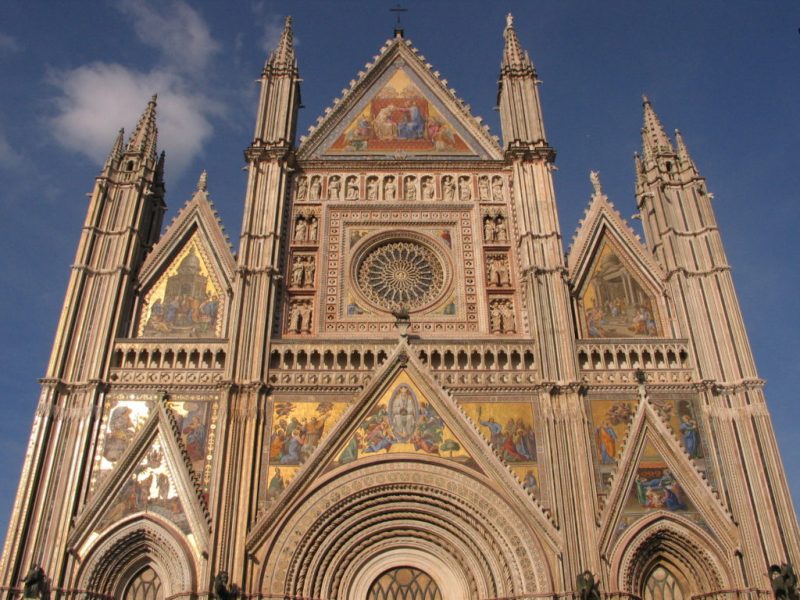
"One of the most celebrated cathedral in Italy"
November-February: 9.30am – 5.00pm (Sundays 1.00pm– 4.30pm)
April-September: 9.30am – 7.00pm (Sundays 1.00pm – 5.30pm)
March and October: 9.30am – 6.00pm (Sundays 1.30pm – 6.00pm)
Ticket: € 8,00
(includes cathedral, San Brizio chapel, Museo dell’Opera del Duomo and Duomo undergrounds)
Children up to 10 years old are free
A symbol of the city itself, the Duomo is one of the most beautiful in Italy. The construction began in 1290, with the support of both the Catholic Church and the city. The intent was to create one large cathedral for the city, to replace two decaying churches that existed there before. It should also be noted that the delightful story of the event of the Miracle of Bolsena encouraged the construction of the Duomo.
The Duomo is a magnificent building that brings together different architectural styles. In particular we can define a fine example and balance of Gothic and Romanesque styles. There were many people who participated in the various phases of design and construction.
Arnolfo di Cambio, and Lorenzo Maitani, with regard to the design (in particular Maitani for much of the credit of the splendid facade) and a lot of sculptors, goldsmiths and painters as regards the landscaping and finishing.
Among the sculptors is Ippolito Scalza (local architect of several works in Orvieto including the Town Hall), which can be seen inside the Duomo, the Statua della Pietà. Among the painters are Ugolino di Prete Ilario, Gentile da Fabriano, Beato Angelico and Luca Signorelli’s frescoes in particular for the two beautiful chapels. the chapel of San Brizio, and the chapel of SS Corporale.
- The mosaics of the Cathedral of Orvieto
- Rose window of the Cathedral of Orvieto
- Bas Reliefs of the Cathedral of Orvieto
- The San Brizio Chapel and The Corporale Chapel
- Statues of the Cathedral of Orvieto
- Crypt and Cathedral undergrounds
- The Torre di Maurizio
THE MOSAICS OF THE DUOMO OF ORVIETO
The mosaics of the facade of Orvieto Cathedral concern the Virgin to which the cathedral was dedicated. The mosaics tell the story and scenes from the life of the Virgin, the assumption into Heaven, the Nativity, up to the Coronation. In the segments on either side of the gables there are images of The Annunciation, The Apostles in Ecstasy for the Assumption of the Virgin, Joachim and Anna. Finally, in the upper cusps are represented: The Marriage of the Virgin, the Presentation of Mary in the Temple, the Coronation of Mary.
ROSE WINDOW OF THE DUOMO OF ORVIETO
The Rose Window, by Andrea di Cione, also known as Orcagna (1354-1380), is the focal point and catalyst for the observer of the cathedral facade. It consists of a double row of columns with intersecting arches, where the center stands the face of Christ the Redeemer surrounded by mosaics in 4 triangles. These are by Piero di Puccio (1388), and depict the four doctors of the church: St. Augustine, St. Gregory the Great, St. Jerome and St. Ambrose. Externally, the Rose Window is surrounded by sculptures representing, among others, the apostles and 12 prophets. The statues and the heads are in travertine.
The bronze sculptures that decorate the facade of the Duomo symbolize the four Evangelists and, the Angel (St. Matthew), the Lion (San Marco), the Eagle (St. John) and the Bull (St. Luke).The bronze sculpture above the central door is the Virgin and Child, which was recently restored. The bronze works that symbolically represent the four evangelists are the work of the Maitani.
In 1970 the original wooden doors of the cathedral were replaced with the bronze doors. The latter represent the Works of Mercy, a work by the Sicilian sculptor Emilio Greco. The ground floor of Palazzo Soliano, houses a museum dedicated to him with an exhibition of some of his works in bronze.
BAS RELIEFS OF THE DUOMO OF ORVIETO
The four cathedral pilaster have large marble bas reliefs, each representing images and stories of a religious nature:
The first relief depicts stories of the Old Testament with images depicting the history of Genesis. These are scenes that trace the days of creation (creation of animals and plants) and the birth of Adam and Eve. Other scenes in this pilaster depicting Eden, the original sin, the divine condemnation and symbolic presentation of Cain slaying Abele.
In the second relief we have the Tree of Jesse, with the genealogy of the descendants of Jesus and Messianic prophecies and scenes with Abraham, King David, Solomon and the Crucifixion.
In the third relief are the gospel stories narrated in the New Testament, with scenes of the activity of Christ, the Nativity and the Annunciation. Other scenes in particular the massacre of the innocents, the kiss of Judas, the scourging of Christ and Mary at the holy sepulcher.
In the fourth relief it is represented a recurring theme in the arts representational works of the Cathedral: the Last Judgement. Images of the damned and the elect, the resurrection of the dead. The same theme is beautifully represented in painting the frescoes by Signorelli in the Chapel of San Brizio with apocalyptic scenes and the resurrection of the body.
THE SAN BRIZIO AND THE CORPORALE CHAPELS
Of particular value and beauty are the frescoes by Luca Signorelli in the Cappella di San Brizio (San Brizio chapel) where the artist plays with skill and very engaging choreography, the theme of the Last Judgment, in a striking alternation of apocalypse and redemption. The Cappella of SS Corporale has frescoes based on scenes from the Bible and sacred representations of the Eucharistic Miracle of Bolsena.
Among them stands out the painted panel depicting the “Madonna dei Raccomandati” by Lippo Memmi (dated 1320). The same chapel housed for many years the shrine of the Corporale (admirable work of the goldsmith Ugolino di Vieri) and on display is the tabernacle containing the Holy Body of linen stained by the blood of Jesus at the Miracle of Bolsena. The Tabernacle with the sacred linen is carried in procession every year at the Feast of Corpus Domini after a historical procession. Actually the Corporale has been moved and it’s visibile in a specific room of the Museo dell’Opera del Duomo. Also inside the Duomo you can admire many other decorative elements of absolute beauty, such as the “fonte battesimale” and the massive pipe organ.
In the month of March 2019, after a long period, the two statues of the sculptural cycle of the “Annunciazione” made by Francesco Mochi in the early 600s were placed in the Cathedral, on the sides of the high altar.
The two sculptures have great artistic importance, in particular, the statue of St. Gabriel the Archangel announcing (1603) has been recognized as the first baroque statue in history.
However, much of what in the past contributed to inside decor, such as statues, paintings, and jewelry, are now kept in museums in Orvieto, and waiting to be exposed according to a plan of restoration and reorganization of the Museum Opera del Duomo in the Palazzi Papali. Under this project, the new exhibition area will offer visitors the chance to admire the precious objects that are part of the furnishings of the Duomo, as well as all the ancient papers, sketches and original designs that belong to the Opera del Duomo, and were used to create this magnificent monument.
THE STATUES OF THE DUOMO OF ORVIETO
The interior of the Duomo also houses masterpieces of sculpture as well as painting. Among the most important works, the statue of the Pietà (or Deposition) by Ippolito Scalza, a work created from a single block of marble that represents, with great drama, the moment of the deposition of Christ. From the year 2019 the return of the statues that for years have been exhibited at the former church of Sant’Agostino has been completed and that today they are again positioned inside the cathedral after that at the end of the 800, they were removed following the important restorations. On the sides of the high altar, you can admire the two statues of the sculptural cycle of the Annunciation made by Francesco Mochi in the early 600s. The two sculptures have a great artistic importance, in particular, the statue of San Gabriele Arcangelo Annunciante (1603) has been recognized by various scholars, as the first baroque statue in history.
The statue of the Madonna announced was carved in 1608. The two statues are closely related to each other in meaning and message.
Since November 2019, the spectacular group of statues of the Apostles (12 larger than life statues, located at the columns of the central nave) is now located in the Duomo. The Apostles, made between the second half of the ‘500 and the’ 600 by Francesco Mochi, Simone Mosca, Giambologna, Ippolito Scalza and Raffaello da Montelupo.
CRYPT AND DUOMO UNDERGROUNDS
The less visible places of the cathedral are also very interesting, ie the underground areas. The crypt, located in a wing to the left of the Cathedral, was built around the year 1335. Inside there are frescoes from 1300 to 1400, in addition it plays an important spiritual and religious role as the Bishops are buried there of the history of Orvieto whose names are imprinted in the stones that make up the paved access floor.
On the right side instead of the cathedral there is another entrance (part of the Museo dell’Opera del Duomo) which allows you to visit another underground section. Here are still visible finds and old objects used for the construction of the Cathedral.
THE TORRE DI MAURIZIO
The nearby Torre di Maurizio is located between the square and the beginning of Via del Duomo; on top of this medieval tower is still working and prominent bronze statue that “strikes the hours” hitting a large bell with a hammer.
The original function of this mechanism was to “clock de muriccio” (muriccio means construction site) so the name later became popularly “Maurizio”), mark the times for the workers working on the construction of the Cathedral.
In 2014 the Cathedral was the center of the Extraordinary Jubilee commemorating the 750th anniversary of the Eucharistic Miracle of Bolsena and the first establishment of the religious catholic feast of Corpus Domini (Corpus Christi), one of the most important religious celebration for all the catholics.



